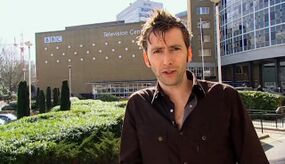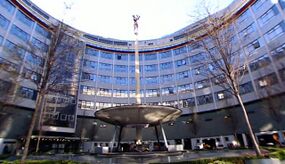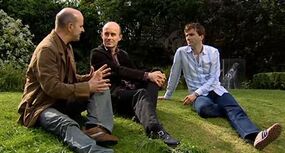BBC Television Centre: Difference between revisions
(add update request) |
(-{{update}}. article didn't actually suggest that the building stood vacant; only that it closed, which is an accurate description. article amended to better clarify that point.) |
||
| Line 1: | Line 1: | ||
{{real world}} | {{real world}} | ||
[[File:DTTVC.jpg|thumb|[[David Tennant]] outside TVC in 2007.]] | [[File:DTTVC.jpg|thumb|[[David Tennant]] outside TVC in 2007.]] | ||
'''BBC Television Centre''' was a television production facility in Shepherd's Bush in the [[London]] borough of [[Hammersmith]] and Fulham. It was located within walking distance of the former site of [[Lime Grove Studios]] and close to [[Riverside Studios]]. It is one of the oldest buildings in the world specially built for television production, officially opened on 29 June 1960. It closed on 31 March 2013, more than 50 years after its opening. | '''BBC Television Centre''' was a television production facility in Shepherd's Bush in the [[London]] borough of [[Hammersmith]] and Fulham. It was located within walking distance of the former site of [[Lime Grove Studios]] and close to [[Riverside Studios]]. It is one of the oldest buildings in the world specially built for television production, officially opened on 29 June 1960. It closed as a BBC facility on 31 March 2013, more than 50 years after its opening.<ref name=closure>[http://www.standard.co.uk/news/uk/bbc-television-centre-closes-its-doors-for-the-last-time-8555435.html "BBC Television Centre closes its doors for the last time" ''London Evening Standard''. 31 March 2013.]</ref> | ||
Although most intimately connected to the colour era of the original series of ''Doctor Who'', it has been used to record at least parts of stories of each of the first nine Doctors, except the [[Eighth Doctor|Eighth]], and has been the subject of [[Do You Remember the First Time? (CON episode)|an episode]] of ''[[Doctor Who Confidential]]'' directed and hosted by [[David Tennant]]. | Although most intimately connected to the colour era of the original series of ''Doctor Who'', it has been used to record at least parts of stories of each of the first nine Doctors, except the [[Eighth Doctor|Eighth]], and has been the subject of [[Do You Remember the First Time? (CON episode)|an episode]] of ''[[Doctor Who Confidential]]'' directed and hosted by [[David Tennant]]. | ||
== Site | == Site history == | ||
[[File:TVCFountain.jpg|thumb|TVC's famous central fountain]] | [[File:TVCFountain.jpg|thumb|TVC's famous central fountain]] | ||
[[File:TennantMoffatTC8.jpg|thumb|[[Steven Moffat|Moffat]] and Tennant in TC8]] | [[File:TennantMoffatTC8.jpg|thumb|[[Steven Moffat|Moffat]] and Tennant in TC8]] | ||
| Line 12: | Line 11: | ||
Building commenced on Television Centre almost at the dawn of the television age in Britain. Groundbreaking was in 1951, and the building was officially opened in 1960. At the time it was possessed of a highly innovative design that allowed all its studios to be essentially interchangeable. Even the exterior was remarkable, as it deliberately formed the shape of a question mark.<ref>The "question mark" design is readily apparent in this satellite imagery: <center><googlemap lat=51.5104 lon=-0.2262 type=hybrid zoom=17 width= height=400 controls=none selector=no scale=yes></googlemap></center></ref> Numerous upgrades to the site allowed it to maintain its utility as a producer of drama into the 1990s. However, as the whole basis of the design had assumed multi-camera, video recording, TV Centre suddenly became useless when most dramas switched to single camera set-ups. The BBC Wales version of ''Doctor Who'', for instance, simply could not be filmed at Television Centre due to this inherent design element. In the mid-1990s, it switched its focus from drama to news and other forms of non-fictional entertainment that still use multiple cameras. However, a 2007 assessment determined that, even with the change of emphasis, the facilities were still under-used. As a result, a decision was taken to sell off the property in an effort to make better use of the BBC's assets. | Building commenced on Television Centre almost at the dawn of the television age in Britain. Groundbreaking was in 1951, and the building was officially opened in 1960. At the time it was possessed of a highly innovative design that allowed all its studios to be essentially interchangeable. Even the exterior was remarkable, as it deliberately formed the shape of a question mark.<ref>The "question mark" design is readily apparent in this satellite imagery: <center><googlemap lat=51.5104 lon=-0.2262 type=hybrid zoom=17 width= height=400 controls=none selector=no scale=yes></googlemap></center></ref> Numerous upgrades to the site allowed it to maintain its utility as a producer of drama into the 1990s. However, as the whole basis of the design had assumed multi-camera, video recording, TV Centre suddenly became useless when most dramas switched to single camera set-ups. The BBC Wales version of ''Doctor Who'', for instance, simply could not be filmed at Television Centre due to this inherent design element. In the mid-1990s, it switched its focus from drama to news and other forms of non-fictional entertainment that still use multiple cameras. However, a 2007 assessment determined that, even with the change of emphasis, the facilities were still under-used. As a result, a decision was taken to sell off the property in an effort to make better use of the BBC's assets. | ||
On 16 July 2012, it was announced that Centre was sold to Stanhope plc for around 200 million pounds.<ref>[http://www.bbc.co.uk/ariel/18783351|Television Centre to be sold for around £200m]</ref> The building was closed officially on 31 March 2013. | On 16 July 2012, it was announced that Centre was sold to Stanhope plc for around 200 million pounds.<ref>[http://www.bbc.co.uk/ariel/18783351|Television Centre to be sold for around £200m]</ref> The building was closed officially on 31 March 2013. As a {{w|Grade II listed building}}, it was not demolished thereafter, but instead extensively refurbished by its new owners. Space was then rented to several parties, including the BBC. Various parts of the BBC returned to the site over the next few years, as the new owners completed their remodelling. The BBC thus maintained a presence on the site — as a lessee.<ref name=closure/> | ||
== Alternate name == | == Alternate name == | ||
Revision as of 15:44, 12 January 2014

BBC Television Centre was a television production facility in Shepherd's Bush in the London borough of Hammersmith and Fulham. It was located within walking distance of the former site of Lime Grove Studios and close to Riverside Studios. It is one of the oldest buildings in the world specially built for television production, officially opened on 29 June 1960. It closed as a BBC facility on 31 March 2013, more than 50 years after its opening.[1]
Although most intimately connected to the colour era of the original series of Doctor Who, it has been used to record at least parts of stories of each of the first nine Doctors, except the Eighth, and has been the subject of an episode of Doctor Who Confidential directed and hosted by David Tennant.
Site history

Building commenced on Television Centre almost at the dawn of the television age in Britain. Groundbreaking was in 1951, and the building was officially opened in 1960. At the time it was possessed of a highly innovative design that allowed all its studios to be essentially interchangeable. Even the exterior was remarkable, as it deliberately formed the shape of a question mark.[2] Numerous upgrades to the site allowed it to maintain its utility as a producer of drama into the 1990s. However, as the whole basis of the design had assumed multi-camera, video recording, TV Centre suddenly became useless when most dramas switched to single camera set-ups. The BBC Wales version of Doctor Who, for instance, simply could not be filmed at Television Centre due to this inherent design element. In the mid-1990s, it switched its focus from drama to news and other forms of non-fictional entertainment that still use multiple cameras. However, a 2007 assessment determined that, even with the change of emphasis, the facilities were still under-used. As a result, a decision was taken to sell off the property in an effort to make better use of the BBC's assets.
On 16 July 2012, it was announced that Centre was sold to Stanhope plc for around 200 million pounds.[3] The building was closed officially on 31 March 2013. As a Grade II listed building, it was not demolished thereafter, but instead extensively refurbished by its new owners. Space was then rented to several parties, including the BBC. Various parts of the BBC returned to the site over the next few years, as the new owners completed their remodelling. The BBC thus maintained a presence on the site — as a lessee.[1]
Alternate name
Television Centre is sometimes referred to as "Shepherd's Bush" by BBC employees, perhaps because it is the usual penchant for studios to have simple geographic names, like "Ealing", "Lime Grove", or "Teddington". This would have been especially appropriate during the period Television Centre was being most heavily used by Doctor Who, as it was merely the centre of a whole cluster of buildings in Shepherd's Bush that the BBC used in various capacities to produce their content. This tradition has been maintained in the BBC Wales production of Doctor Who, in which the "BBC Studios" are frequently called "Upper Boat", in deference to their location.
As recording studio
As location
- The view from Television Centre's front entrance, across the road toward White City tube station was used to place Ian Chesterton's and Barbara Wright's return to Earth in The Chase.File:RorysHospitalOnComputerDisplayOrientedNorthUp.jpgOverhead view as seen in The Power of Three, re-orientated with north at the top.
- Hammersmith Park, next to Television Centre, doubled as the pitch of Lord's Cricket Ground for the Doctor's TARDIS' momentary materialisation in The Daleks' Master Plan.
- The front doors of Television Centre doubled as the entrance to the World Ecology Bureau in The Seeds of Doom.
- An overhead view of the complex was used in The Power of Three, rotated such that west was at the top and the question mark shape was roughly upright. The building highlighted as Rory Williams' hospital was BBC Centre House.
- In the spring of 2013, around the time of its closure, the Television Centre was used as a major filming location for the anniversary drama An Adventure in Space and Time, which was identified as one of the last dramas to be filmed at the Centre before its decommissioning. Around this same time, several scenes for the anniversary spoof The Five(ish) Doctors Reboot were shot just outside the facility as part of a joke about the fact Doctor Who is now filmed in Cardiff.
As documentary subject
Television Centre was the subject of David Tennant's documentary, "Do You Remember the First Time?", aired as episode 10 of the third series of Doctor Who Confidential. Extensive historical and modern footage of the building was featured, including a cursory examination of which episodes of classic Doctor Who were filmed in which specific studios. For most of the "walkabout" tour of the complex, Tennant was accompanied by writer and future Doctor Who showrunner, Steven Moffat.
It also serves as the backdrop to some of Jon Pertwee's narration of The Pertwee Years, a direct-to-video retrospective on his era in Doctor Who.
In other media
Television Centre is the location of an Eighth Doctor comic, "TV Action!", in which the Eighth Doctor and Izzy Sinclair chase Beep the Meep into an alternate universe. There, they land on 12 October 1979 just outside what is presumably the "real" Television Centre. A mad chase through various studios ensues, but Beep has mistaken Tom Baker for the real Fourth Doctor. Beep wishes to extract revenge against Baker for the events of the Fourth Doctor strip, "The Star Beast", but in the end, the actor's tendency to ramble subdues the alien long enough to allow Izzy to overload Beep's Black Star drive, ending the adventure. Much of Television Centre is reasonably accurately portrayed, with the main entrance, central fountain, Blue Peter garden, and circular studio space being recognisably captured by artist Roger Langridge.
Notes
- ↑ 1.0 1.1 "BBC Television Centre closes its doors for the last time" London Evening Standard. 31 March 2013.
- ↑ The "question mark" design is readily apparent in this satellite imagery:
<googlemap lat=51.5104 lon=-0.2262 type=hybrid zoom=17 width= height=400 controls=none selector=no scale=yes></googlemap> - ↑ Centre to be sold for around £200m



